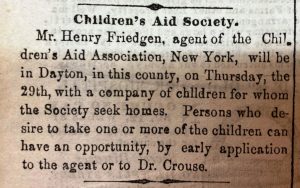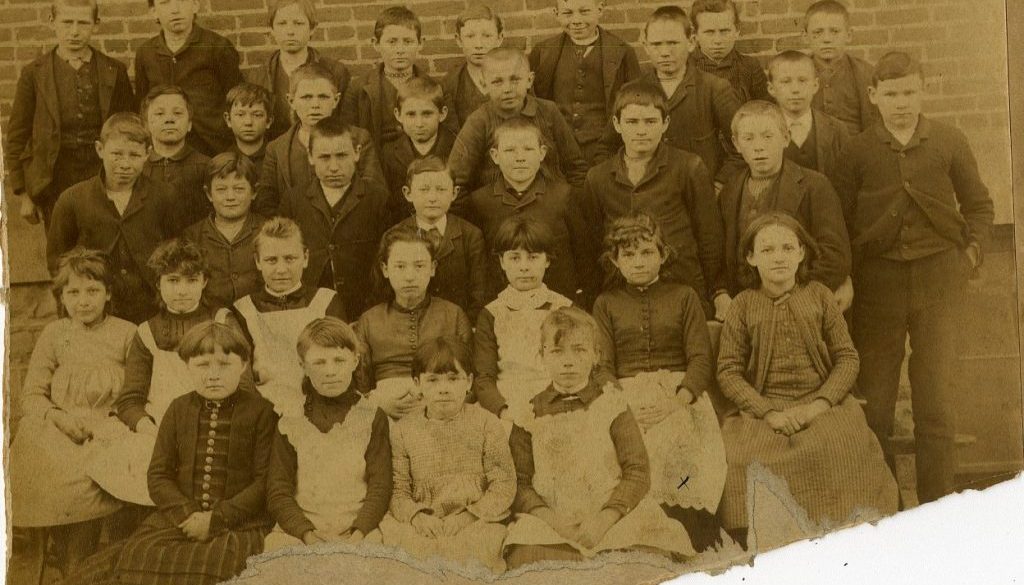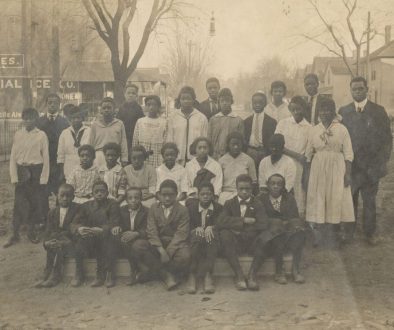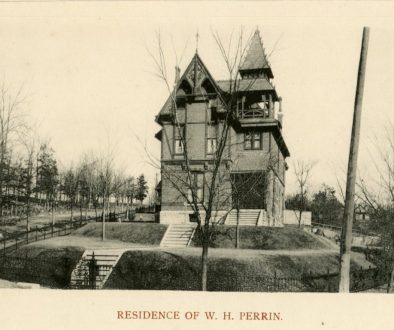The Orphan Train in Tippecanoe County
By Amy Harbor, Research Library Coordinator
The Children’s Aid Society of New York City was founded in 1853 with the purpose of improving the living conditions of some 10,000 vagrant children in the city. Its first Secretary, Charles Loring Brace, developed programs to provide education, housing, food, clothing and medical care to impoverished children, with the aim of keeping them off the streets. One of the most well-known programs promoted by Brace was placing disadvantaged urban children in Christian homes in rural areas. Several times a month, groups of children were rounded up in groups, given new clothing and escorted to the train station. There they were met by Agents who took them by train on a three to four day journey to new homes on farms in the Midwest. Although later the subject of much criticism, in the early days the Orphan Train Movement was well received in the agricultural states of the Midwest. Hundreds of children were transported from the slums and streets of cities on the East Coast to new lives on farms in Indiana as well as other states.

The 1860 annual report of the Children’s Aid Society shows that 352 children came to Indiana that year. Henry Friedgen was noted in the report as having brought five groups totaling 206 children to Indiana in 1860. Several of those groups came to Tippecanoe County. Notices were placed in local newspapers announcing the impending arrival of orphans from New York, and families turned out at the appointed time and place to choose children, or to simply watch the proceedings. After each stop, Mr. Friedgen wrote letters back to Mr. Brace in New York letting him know how the placements had gone. While in the area, he would also check on placements from his prior trips. In January of 1860, Friedgen wrote that he visited Dayton, Indiana where he had placed 58 children one year earlier. On this trip he brought 44 more children to be placed in the area. In one heartbreaking letter on 10 February 1860, he wrote to Mr. Brace:
I wrote to you on the 5th instant, to inform you that the children were all placed in good homes, except three large and three small boys. The last boy I had to dispose of was the deaf mute. I had almost given up all hopes of finding somebody who would take the responsibility of taking this unfortunate, but very interesting boy. (He is eleven years old, either of German or Italian descent.) But the Lord was with us, and guided our footsteps to a place where there are two families living, containing seven deaf and dumb persons, and one little girl about eight years old, the only one who can speak with her tongue and by signs. They are wealthy, and people of a highly moral and Christian character.…. They embraced the boy, and concluded at once to keep him, and give him, not only a home, but educate him also.
Later in the 1860 report, the following letter from the deaf-mute farmer to Mr. Friedgen was included:
C—– H——, Ind. March 5th, 1860
My Dear Sir: I received your kind letter some days ago. The first of the time when you left D—–, he cried and stamped on the floor by the door, but I took him to show him the horses; I told him when he will be a big man, I would give him a horse. Then he quit crying, and he began to learn A, B, C, on that day when you left here. Now D—– is doing very well. I am willing to take care of him over twenty-one years old, if he stays here as long as he ever gets to be twenty-one years old; then I will give him a horse, money, clothes, school, etc.
Yours truly, friend, L. F. W.
It didn’t take much sleuthing to learn that L.F.W. was Luther F. Wall, a farmer in the Clarks Hill area. Looking at the 1860 Census for Tippecanoe County, I learned that the boy’s name was David Broker.
Luther Wall was born to hearing parents, Richard and Theodocia Wall in 1823. Natives of Pennsylvania, the Wall family came to Tippecanoe County by way of Kentucky, around 1830, when Richard purchased five 80 acre parcels in Lauramie Township, just south of Clarks Hill. Richard and Theodocia had 9 children who grew to adulthood, and four of them, two boys and two girls, were deaf. The boys, Luther and Calvin were among the first students to attend the Indiana School for the Deaf, which was founded in 1843. Both spent seven years at the school, and married deaf women. Two of Luther’s three children were also deaf, one dying in infancy. A small community of deaf people grew up in the area, as the 1860 Census shows that both Calvin’s and Luther’s households included several farm laborers who were deaf. Tragically, Luther died in 1864 after being run over by a train, and Calvin was accidentally shot to death on his way to California. Luther’s wife Arietta died in 1871.
Luther Wall followed through on his promise to educate David Broker. Records show David was admitted to the State School for the Deaf in 1861 at the age of 12, and he was still there in 1870. He married Watty Street in 1878 in Grant County. Watty, who was also deaf, was also educated at the Indiana School for the Deaf. David and Watty had two daughters and a son, none of whom was deaf. For most of his adult life, David worked as a factory laborer, including in a plate glass factory and an iron foundry. The family moved several times, living in Logansport, Kokomo, Hartford City, Sweetser, Anderson and Connersville. After Watty died in 1895, David lived the rest of his life with his younger daughter’s family in Kokomo. He died on March 12, 1924. David Broker’s obituary in the Kokomo Tribune says he was born on Long Island, New York, but makes no mention of his train trip to Indiana with 43 other orphans. He is described as a “very loving father, very agreeable to all who knew him, and a great help in many ways to those who were unfortunately afflicted in the same way.” David Broker was buried in Logansport with his wife Watty.
To Learn more about the Orphan Train, click on these links:
Orphan Train by Christina Baker Kline
The National Orphan Train Complex Museum & Research Center
Orphan Train Heritage Society of America




